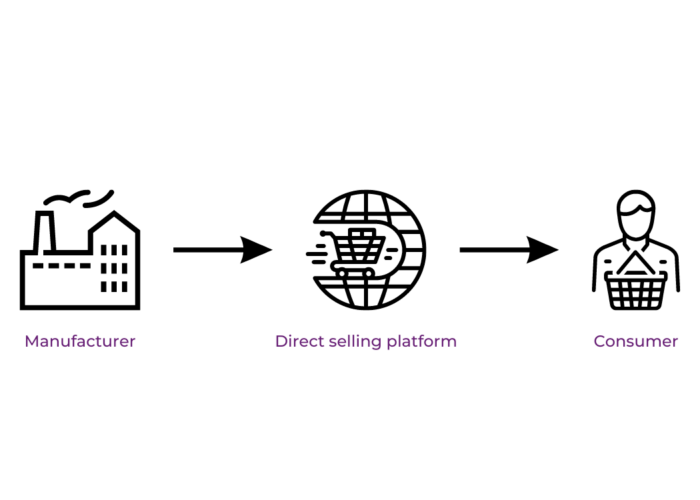Navigating the Direct-to-Consumer Revolution in 2024

In our previous article, we took a detailed look at the challenges that Benelux wholesalers will face in the rapidly changing economic landscape of 2024. With digitalization turning traditional business models upside down, these leaders face the task of meeting growth expectations, continuing to invest in technology and addressing pressing staffing issues.
We focus specifically on the emerging trend of direct-to-consumer (D2C) commerce, where the competitive landscape is evolving and wholesalers must embrace new strategies to remain relevant in an increasingly digitized market.

D2C as a strategy
D2C has emerged as a result of changing consumer preferences and technological advances, with consumers increasingly seeking convenience, personalization and direct interaction with brands. Digital technologies such as e-commerce platforms and social media now allow companies to interact directly with customers and offer products, without intermediaries such as traditional retailers or wholesalers.
This shift enables suppliers to be more responsive to consumers’ needs, have more control over their brand experience and increase margins by eliminating middlemen. Moreover, this approach allows for global operations without a physical presence, while collecting valuable data on consumer behavior, preferences and trends. By using advanced analytics, suppliers can leverage this data to gain a deeper understanding of their customers and markets, allowing them to make strategic decisions and optimize their product offerings and marketing efforts.
Handling Supplier Relations in a D2C World
Dealing with supplier relationships in a D2C world brings challenges, especially in finding a balance between wholesalers and suppliers. Wholesalers need to strive for optimal prices on the one hand while anticipating the emergence of D2C suppliers on the other.
Wholesalers must develop strategies to maintain this balance, such as promoting transparent communication with suppliers about D2C activities and identifying mutually beneficial collaboration opportunities, such as joint marketing initiatives.
In addition, wholesalers should rethink their relationships with suppliers in light of the shift to D2C and the growing demand for personalized products. This means closer collaboration between wholesalers and suppliers to develop customized products that meet consumers’ needs, allowing them to stand out in the market and offer more value to their customers.
Differentiation strategies for Wholesalers
Understanding the market, including trends, growth segments and emerging opportunities, is an essential first step for wholesalers.
Following this analysis, it is necessary to examine the competition to identify strengths and weaknesses and understand how wholesalers can differentiate themselves.
In addition, it is crucial to develop a deep understanding of customers, including their needs, preferences and buying behavior.
With these insights, wholesalers can differentiate themselves through various differentiation strategies. Such as offering unique products and services, providing excellent customer service, creating a strong brand identity and developing innovative distribution channels. Examples of such distribution channels include online marketplaces such as Amazon Business, and Alibaba, or specific niche platforms, which allow wholesalers to sell directly to consumers without the need for extensive online infrastructure.
Another example is the use of dropshipping, where the wholesaler ships products directly to the end customer on behalf of the retailer, allowing wholesalers to reach new customers through retailers who do not want to hold large inventories while reducing operational costs and logistics challenges.
The benefits for wholesalers of deploying technology
Technology offers wholesalers a wide range of opportunities to gain a competitive advantage and stand out in the market. Key challenges, such as inventory management and optimisation, customer relationship management, operational efficiency and the transition to e-commerce and digital commerce, can be effectively addressed with technology solutions.
By first conducting a thorough market analysis, new insights can be gained about market supply and demand. This enables wholesalers to think ahead and anticipate the increasingly rapid changes in consumer behavior. With advanced WMS and data analytics, wholesalers can optimize their inventory levels and reduce operational costs. By closely monitoring inventory, money can be prevented from being tied up in the warehouse without sacrificing the ability to meet consumer demand. This allows companies to directly anticipate the emerging trend of D2C, for example and helps secure the supply chain against supply risks.

After analyzing the market and figuring out the supply chain, it is crucial to attract and retain these customers. Effective customer relationship management is facilitated by CRM software, which allows wholesalers to track customer interactions, analyze data and develop personalized marketing campaigns. Linking this to an E-commerce platform creates a seamless integration between wholesaler and customer, offering huge potential for personalized catalogs and marketing. This also promotes customer loyalty. By building improved relationships from this approach through branding and loyalty initiatives from one central source.
Technological solutions such as automation, document management and an ERP system help streamline processes and improve overall operational efficiency. Specifically, these could be orders that are automatically synchronized to different departments, relevant information that can be found in seconds, or monitoring supplies. These are just a few examples.
In short, it is essential to reduce human input, both to customers and suppliers. This not only saves time and accurate data but also gives room to work out strategic decisions, such as partnering with suppliers.
Key Takeaways
This includes setting up joint marketing initiatives and developing customized products to meet the growing demand for personalized services and encourage differentiation in the market.
Innovative distribution channels enable wholesalers to explore new sales channels and increase market share without having to set up an extensive infrastructure.
While CRM software tracks customer interactions and enables the development of personalized marketing campaigns. In addition, technology solutions such as automation, document management and ERP help streamline processes and improve overall operational efficiency.

The value Amista delivers to wholesale operations
At Amista, we strive to provide our customers with innovative solutions and high-quality services, aiming to improve their operational efficiency and drive sustainable growth.
Our approach is based on five essentials. First, we aim to provide strong ERP platforms that offer flexibility for future innovations and customer-centric approaches. Next, we focus on seamlessly integrating systems across different business applications. We also focus on implementing intelligent document processing systems to promote paperless processes. In addition, we provide learning and change management support, helping wholesalers maximize the benefits of innovation and transformation. Finally, we emphasize creating customer experiences through personalized approaches. We make sure you love it!
Ready to thrive in the D2C revolution?
Contact us and together we will see what we can do for you.
